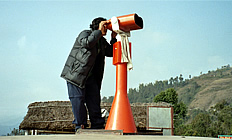 |
|
Maoist
insurgency and tourism
|
| Travelling
inside Maoland: Reports |
|
 |
Maoist
rebels have robbed money and personnel equipment after from two visitors
,a Nepal and a Japanese national, of a slate mine in Dolakha district.
The Maoist charged them their revolutionary tax before.
| Trekking
in the time of terrorism |
Until
two years ago, the trail from Terathum to Milke Danda and Jaljale Himal
in the rhododendron season would be one long line of trekkers and porters.
This
year, the mountains are ablaze again with Nepal's national flower. The
trees are sagging a bit under the weight of late spring snow here in eastern
Nepal and it's not just red, there are blossoms of every shade from pure
white to deep red. But there are few trekkers here to enjoy the sight.
This
is also the route to Kangchenjunga Base Camp via Taplejung and where rafters
used to come to raft down the Tamur and Arun. But this spring there has
been only a sprinkling of mountaineers headed up the mountains.
| Travelling
across Terathum is now like going to Rukum |
Across
the green hills of eastern Nepal, with its scented forests and grand vistas,
travelers are lulled into dreaming that peace has returned to this land.
But the numerous checkpoints along the way, the charred hulks of burnt
vans and tree trunks by the side of the road prove that even here the conflict
is never very far away.
For
the first six years of the conflict, eastern Nepal was largely unaffected.
But the violence creeped in stealthily like a dangerous unseen epidemic.
By 2003, the hinterlands of Khotang, Terathum, Sankhuwa Sabha, Bhojpur,
Taplejung and Panchthar were reeling under Maoist tactics of murders, bombings
and blockades. The chief architect of the Maoist expansion in the Arun
Valley has been Basu Sakya, whose intention was to make Sankhuwa Sabha
'the Rolpa of the east'.
| Trekking
through Nepal's changing political landscape |
The
first time I visited Nepal in 1999, the people were shrugging the Maoists
off as a flash in the pan. A year later they were seen as a nuisance. By
2002, villagers had fear written on their faces and in 2004, it had changed
to a heavy feeling of despair, resignation and fading hope. They were fed
up with extortion, the fall in trekking tourism caused by the insurgency
and felt let down by successive governments in Kathmandu incapable of resolving
the crisis.
The
timing of the present crisis couldn't have been worse. February First happened
just as bookings for the spring trekking season were firming up and the
travel trade was looking forward to recouping losses of the past years.
Although
there was a 12 percent increase in tourist arrivals last year with 380,000
visitors, it was still way below the 1998 peak of 500,000. Now, things
are gloomy again.
There
have been mass cancellations after news of the king's move and the subsequent
Maoist blockade of highways. January had already shown a 16 percent drop
compared to January 2004 and February's figures are expected to be worse.
After
the emergency was declared, Kathmandu-based embassies have upgraded their
travel advisories. Even the French, who have been the most laissez-faire
about advisories on Nepal have posted warnings, mainly because of communication
difficulties after 1 February.
 |
 |
External
links |
|




